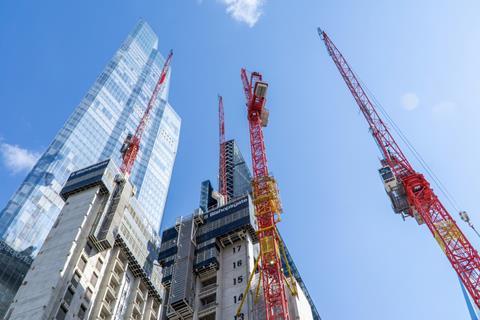Surprise growth in May comes from strong performance in commercial and private housebuilding
A surge in commercial work and private housebuilding drove a stronger than expected increase in construction output in May, according to official figures published today.
Construction output increased by 1.5% in the month – the seventh consecutive monthly increase – to hit its highest level since monthly figures were first recorded in January 2010.
The increase came solely from new work, which was up 2.8%, with repair and maintenance dipping slightly, with the increase in new work driven particularly by the ongoing recovery in the commercial construction sector, which increased by 12% month-on-month.

Private housebuilding work also increased sharply, up 7.2% on the month – which is likely to come as a relief to the sector after several months of apparently stagnating numbers.
The Office of National Statistics said that seasonally adjusted data showed that construction output reached £15.05bn in May – which is the first time output has topped £15bn, seasonally adjusted, for a single month.
The level of output is now 4.1% above the February 2020 pre-covid level overall, with new work slightly down on where it was, and repair and maintenance slightly up.
The ONS said this high level of output was achieved despite “continual issues in sourcing certain construction products”, while “high costs for products such as concrete, bricks and timber are still mentioned” in its survey returns.
It added: “There are also ongoing shortages of many materials, particularly for the smaller sized firms. Also, significant mentions of higher fuel costs and VAT tax increases for red diesel have had an impact this month.”
Mark Robinson, group chief executive at procurement specialist Scape, said the return to growth would “come as a surprise to many across the industry” given that the general consensus was that inflation was “curbing longer term development plans”.
He said: “With the political picture facing significant change, fixing the economy has been put on the back burner just as the construction industry faces a critical peak season.
> Also read: Current political chaos could cast long shadow over our industry
“All eyes will be on the economic plans of the leading Tory candidates. Any suggestion that austerity could return, in a bid to tackle the national debt, might cause concerns that a slowdown in public sector investment could compound the decline we’re starting to see in the private sector.”
Simon Rawlinson, a partner at Arcadis, said the 2.8% increase in activity in May was very positive. “This points to the continuing resilience of the investment side of the economy in the face of the cost of living crisis,” he said. “How sustainable this pattern of growth is into the second half of the year is questionable but, at present, healthy demand is supporting a buoyant construction sector.”
Brian Berry, chief executive of the Federation of Master Builders, was more cautious. “The positive numbers in the latest ONS stats mask a worrying underlying trend,” he said. ”Activity in the repair, maintenance and improvement sector (RMI) continues to fall, likely influenced by consumers juggling rising cost of living pressures.
“RMI work is the backbone of the construction industry and the lifeblood of small, local builders. If the decline continues, insolvencies will follow.
“The ONS is right to point to the pressures of high costs of construction products, lack of materials, high fuel costs and the ban on red diesel as having an impact on the sector. All these costs add up and must be passed on to a reluctant customer base who are looking to make savings.”




























No comments yet